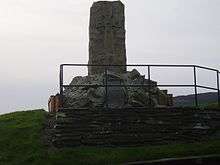Dunoon massacre
The Dunoon massacre was a massacre that took place around Dunoon on the Cowal Peninsula, Scotland, on June 3, 1646. Men of the powerful Clan Campbell massacred men, women and children of the Clan Lamont.[1]

By 1646, the Clan Campbell, neighbours of the Clan Lamont, had steadily encroached the Lamont's lands. After the 1645 Battle of Inverlochy near Fort William, the Clan Lamont took the opportunity to lay waste to the Campbell's territory. The following year, the powerful Clan Campbell army invaded the Clan Lamont lands, taking their castles of Toward on Cowal and Ascog on Bute. At Castle Toward the Campbells asked for hospitality, which was given, according to custom, and then slaughtered the Lamonts in their beds finally throwing bodies down the well to poison the water should they have missed anyone. Sir James Lamont surrendered after accepting fair terms for his people, but the Campbells then slaughtered over two hundred of Lamont's men, women and children. Elsewhere, one tree was said to have carried thirty five bodies from its branches, and another thirty six men were buried alive. The two Lamont castles were set alight and razed. Sir James Lamont was thrown into a dungeon for five years. This event became known as the Dunoon massacre.[2][3]
The massacre is commemorated by a memorial in Dunoon, dedicated in 1906 and known as the Clan Lamont Memorial or the Dunoon Massacre Memorial.[4][5]
See also
- List of massacres in the United Kingdom
References
- Levene, Mark & Roberts, Penny. The Massacre in History, Berghahn Books, 1999. ISBN 1-57181-934-7.
- "Massacre of Clan Lamont and the Memorial at Dunoon". Lamont-young.com. Retrieved 10 November 2012.
- "Clan Lamont". Electricscotland.com. 29 July 1913. Retrieved 10 November 2012.
- "Dunoon, Tom A Mhoid Road, Clan Lamont Memorial". CANMORE. Historic Environment Scotland. Retrieved 21 February 2017.
- "Clan Lamont Memorial, Dunoon". Commemorations Project. The Scottish Military Research Group. Retrieved 21 February 2017.